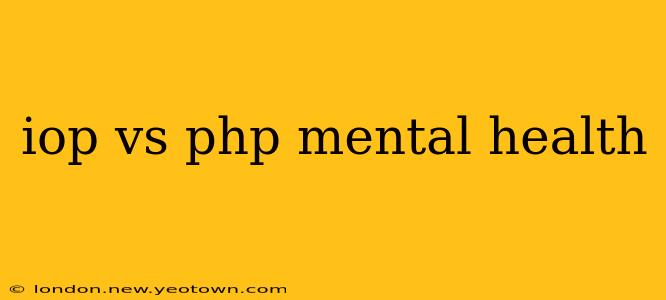IOP vs PHP: Navigating the Maze of Mental Health Treatment Options
The journey to mental wellness can feel like navigating a complex maze, especially when faced with the choices between different levels of care. Two common options often leave individuals feeling confused: Intensive Outpatient Programs (IOPs) and Partial Hospitalization Programs (PHPs). While both offer structured support outside of a 24/7 inpatient setting, their intensity and scope differ significantly. This article will illuminate the key distinctions between IOP and PHP, helping you make informed decisions about your mental health journey.
Let's begin our exploration with a story. Imagine Sarah, struggling with severe anxiety and depression. Her therapist suggested she explore IOP or PHP. Overwhelmed by the terminology, Sarah felt lost. This is a common experience, and understanding the nuances of each program is crucial for finding the right path to recovery.
What is an Intensive Outpatient Program (IOP)?
An IOP is a step-down program from inpatient care or a more intensive intervention for individuals who aren't quite ready for or don't require the level of structure provided by a PHP. Think of it as a structured bridge between individual therapy and the more comprehensive support of a PHP. IOPs typically involve several hours of therapy per week, spread across several days. The focus is on addressing specific mental health challenges through group and individual therapy sessions.
Key Features of IOPs:
- Fewer hours of therapy per week: Compared to PHPs, IOPs generally involve fewer hours of therapy per week.
- More flexibility: IOPs offer more scheduling flexibility than PHPs, allowing participants to maintain some aspects of their daily routines.
- Focus on specific needs: IOPs tailor treatment plans to address specific issues, like substance abuse, anxiety, or depression.
- Suitable for individuals with moderate symptoms: IOPs are suitable for individuals who aren't experiencing severe symptoms requiring 24/7 monitoring but still need significant support.
What is a Partial Hospitalization Program (PHP)?
A PHP provides a more intensive level of care than an IOP. Imagine a daily "day hospital" experience for mental health. Participants attend therapy sessions for a significant portion of the day, often five days a week, for several hours each day. It's a structured environment that offers a higher level of supervision and support. Think of it as a bridge between inpatient hospitalization and outpatient therapy.
Key Features of PHPs:
- More intensive therapy: PHPs provide a significantly higher number of therapy hours per week compared to IOPs.
- Structured daily schedule: The program offers a structured daily schedule with various therapeutic activities such as group therapy, individual therapy, medication management, and recreational activities.
- Higher level of support: PHPs provide a more comprehensive support system including daily check-ins, case management, and regular communication with treatment providers.
- Suitable for individuals with more severe symptoms: PHPs are suitable for individuals experiencing more severe mental health symptoms, requiring a higher level of monitoring.
What are the differences between IOP and PHP?
This table summarizes the key differences:
| Feature | IOP | PHP |
|---|---|---|
| Intensity | Less intensive | More intensive |
| Hours per week | Fewer hours (e.g., 9-12) | More hours (e.g., 20-30) |
| Structure | Less structured | Highly structured |
| Supervision | Less supervision | More supervision |
| Symptom Severity | Moderate symptoms | More severe symptoms |
| Flexibility | More flexible scheduling options | Less flexible scheduling options |
What type of mental health issues are treated in IOP and PHP?
Both IOPs and PHPs can address a range of mental health challenges, including:
- Depression: Both programs offer evidence-based therapies to manage depression symptoms.
- Anxiety disorders: Treatment often includes cognitive-behavioral therapy (CBT) and other techniques.
- Trauma-related disorders: Specialized trauma-focused therapy is often incorporated.
- Substance abuse: IOPs and PHPs can be part of a comprehensive substance abuse treatment plan.
- Bipolar disorder: Mood stabilization strategies and medication management are crucial components.
- Eating disorders: Nutritional counseling and therapy are integrated into the treatment.
- Personality disorders: Treatment addresses specific personality patterns and challenges.
How do I choose between IOP and PHP?
Choosing between an IOP and a PHP depends on various factors, including the severity of your symptoms, your support system, and your personal preferences. A thorough assessment by a mental health professional is crucial to determine the appropriate level of care. Consider these points:
- Severity of Symptoms: Are your symptoms severe enough to require the intensive structure and support of a PHP?
- Daily Functioning: Can you maintain your daily routine while attending an IOP?
- Support System: Do you have a strong support system to help you outside of therapy?
- Personal Preferences: Do you prefer a more structured or flexible program?
The path to recovery is unique to each individual. Understanding the distinctions between IOPs and PHPs empowers you to make informed choices and embark on a journey towards better mental wellness. Always consult with a mental health professional for personalized guidance.

